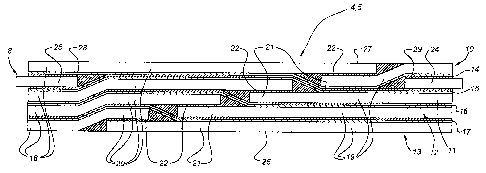Some of the information on this Web page has been provided by external sources. The Government of Canada is not responsible for the accuracy, reliability or currency of the information supplied by external sources. Users wishing to rely upon this information should consult directly with the source of the information. Content provided by external sources is not subject to official languages, privacy and accessibility requirements.
Any discrepancies in the text and image of the Claims and Abstract are due to differing posting times. Text of the Claims and Abstract are posted:
| (12) Patent: | (11) CA 2531536 |
|---|---|
| (54) English Title: | LAMINATE WITH FILL LAYER |
| (54) French Title: | LAMINE COMPORTANT UNE COUCHE DE REMPLISSAGE |
| Status: | Expired and beyond the Period of Reversal |
| (51) International Patent Classification (IPC): |
|
|---|---|
| (72) Inventors : |
|
| (73) Owners : |
|
| (71) Applicants : |
|
| (74) Agent: | SMART & BIGGAR LP |
| (74) Associate agent: | |
| (45) Issued: | 2011-11-29 |
| (86) PCT Filing Date: | 2004-07-07 |
| (87) Open to Public Inspection: | 2005-01-13 |
| Examination requested: | 2009-06-30 |
| Availability of licence: | N/A |
| Dedicated to the Public: | N/A |
| (25) Language of filing: | English |
| Patent Cooperation Treaty (PCT): | Yes |
|---|---|
| (86) PCT Filing Number: | PCT/NL2004/000486 |
| (87) International Publication Number: | WO 2005002834 |
| (85) National Entry: | 2006-01-05 |
| (30) Application Priority Data: | ||||||
|---|---|---|---|---|---|---|
|
A laminate has alternating metal layers and at least one plastic bonding
layer. The metal layers each comprise at least two metal layer sections that
have mutually overlapping edges bonded to one another. To even out the
differences in thickness, a fill is provided which has at least a thickness
such that at the location of the fill the laminate has a thickness equal to
the thickness at the location of the overlapping edges.
Laminé possédant des couches alternées métalliques et au moins une couche de liaison en plastique. Les couches métalliques comprennent chacune au moins deux parties de couche métallique dont les bords se chevauchant sont reliés l'un à l'autre. Un remplissage sert à égaliser les différences d'épaisseur et possède au moins une épaisseur de sorte qu'au niveau du remplissage, le laminé présente une épaisseur égale à l'épaisseur au niveau de l'emplacement des bords qui se chevauchent.
Note: Claims are shown in the official language in which they were submitted.
Note: Descriptions are shown in the official language in which they were submitted.

2024-08-01:As part of the Next Generation Patents (NGP) transition, the Canadian Patents Database (CPD) now contains a more detailed Event History, which replicates the Event Log of our new back-office solution.
Please note that "Inactive:" events refers to events no longer in use in our new back-office solution.
For a clearer understanding of the status of the application/patent presented on this page, the site Disclaimer , as well as the definitions for Patent , Event History , Maintenance Fee and Payment History should be consulted.
| Description | Date |
|---|---|
| Time Limit for Reversal Expired | 2019-07-08 |
| Letter Sent | 2018-07-09 |
| Inactive: Late MF processed | 2013-09-17 |
| Letter Sent | 2013-07-08 |
| Grant by Issuance | 2011-11-29 |
| Inactive: Cover page published | 2011-11-28 |
| Pre-grant | 2011-09-15 |
| Inactive: Final fee received | 2011-09-15 |
| Notice of Allowance is Issued | 2011-03-21 |
| Letter Sent | 2011-03-21 |
| Notice of Allowance is Issued | 2011-03-21 |
| Inactive: Approved for allowance (AFA) | 2011-03-16 |
| Letter Sent | 2011-02-10 |
| Amendment Received - Voluntary Amendment | 2010-11-30 |
| Inactive: S.30(2) Rules - Examiner requisition | 2010-06-01 |
| Letter Sent | 2009-08-14 |
| Request for Examination Requirements Determined Compliant | 2009-06-30 |
| All Requirements for Examination Determined Compliant | 2009-06-30 |
| Request for Examination Received | 2009-06-30 |
| Letter Sent | 2006-04-21 |
| Inactive: Single transfer | 2006-03-15 |
| Inactive: Courtesy letter - Evidence | 2006-03-07 |
| Inactive: Cover page published | 2006-03-06 |
| Inactive: Notice - National entry - No RFE | 2006-03-01 |
| Application Received - PCT | 2006-02-06 |
| National Entry Requirements Determined Compliant | 2006-01-05 |
| Application Published (Open to Public Inspection) | 2005-01-13 |
There is no abandonment history.
The last payment was received on 2011-06-27
Note : If the full payment has not been received on or before the date indicated, a further fee may be required which may be one of the following
Please refer to the CIPO Patent Fees web page to see all current fee amounts.
Note: Records showing the ownership history in alphabetical order.
| Current Owners on Record |
|---|
| FOKKER AEROSTRUCTURES B.V. |
| Past Owners on Record |
|---|
| ABDOEL FAZIEL RAJABALI |
| WILLEM JAN NICOLAAS TER STEEG |